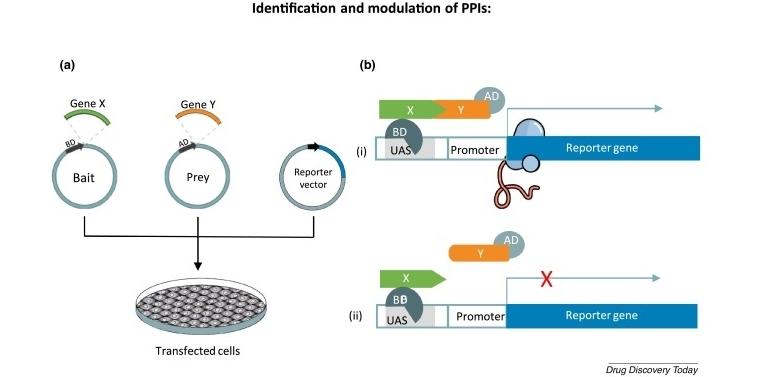Protein-protein interactions, commonly known as PPIs, are of utmost importance in various biological processes, including but not limited to signal transduction, gene expression, and metabolic pathways. The complexity and sheer significance of PPIs require us to comprehend them in their entirety to unravel the mechanisms underlying these processes and generate innovative drugs for treating diseases.
To investigate PPIs in living mammalian cells, the mammalian two-hybrid assay (M2H) has proven to be a potent tool. It is imperative to study PPIs through this technique, as it is one of the most effective ways to gain a comprehensive understanding of the vast intricacies of these interactions.
The Principle of Mammalian Two-hybrid Assay
The M2H assay operates on the Gal4 transcriptional activation system, which comprises two domains - the DNA-binding domain (DBD) and the transcriptional activation domain (AD) of the yeast transcription factor Gal4. The M2H technique utilizes these domains by merging them with two distinct proteins of interest. The fundamental principle of the M2H system lies in the interaction between these two fusion proteins, which brings the DBD and AD domains in close proximity. This closeness allows the transcription of a reporter gene situated downstream of the Gal4 binding site.
 Principle representation of the M2H assay (Patrício et al., 2020)
Principle representation of the M2H assay (Patrício et al., 2020)
The reporter gene can serve various purposes, including acting as a selectable marker gene, such as the antibiotic resistance gene or the luciferase gene, which enables the selection or quantification of cells that demonstrate the desired PPI. Additionally, the reporter gene can be a fluorescent protein gene, such as GFP, that facilitates the visualization of PPIs in living cells. The M2H system can be executed in various formats, such as the mammalian cell two-hybrid system (MCTH) and the mammalian membrane two-hybrid assay (MMTH), based on the location of the fusion proteins.
Applications of Mammalian Two-hybrid Assay
The mammalian two-hybrid (M2H) assay is an exceptionally potent technique that allows for the identification and characterization of protein-protein interactions (PPIs) within living mammalian cells. This methodology has a distinctive advantage over conventional in vitro assays like co-immunoprecipitation and pull-down assays. The M2H assay can identify PPIs in a cellular environment, which offers a more physiologically relevant context for studying protein interactions.
The M2H assay has been extensively utilized to investigate PPIs involved in a broad range of biological processes. These include but are not limited to signal transduction, DNA replication and repair, and protein degradation pathways. For instance, the M2H assay has enabled researchers to identify and validate PPIs implicated in cancer progression and metastasis, infectious diseases, and neurodegenerative disorders.
Furthermore, the M2H assay has been adapted for high-throughput screening of PPIs, which allows for the identification of potential protein partners on a larger scale. The screening of libraries of proteins for potential PPIs provides valuable information regarding protein function and interactions. Additionally, the M2H assay has also been employed in drug discovery and development. It can be used to identify small molecules that disrupt or enhance PPIs, which has tremendous potential for the development of novel therapeutic agents.
 Inducible mammalian two-hybrid (iM2H) system (Riegel et al., 2017)
Inducible mammalian two-hybrid (iM2H) system (Riegel et al., 2017)
Advantages of Mammalian Two-hybrid Assay
The M2H system has several advantages over other methods for PPI analysis:
- Detection of PPIs in living mammalian cells
Unlike in vitro methods, such as Co-IP or in vitro pull-down assays, the M2H system allows for the detection of PPIs in their native context in living mammalian cells. This is particularly important for studying dynamic or transient interactions that may be missed by in vitro methods.
- High sensitivity and specificity
The M2H system has a high sensitivity and specificity for detecting PPIs, as it relies on the transcriptional activation of a reporter gene downstream of the Gal4 binding site. This allows for the quantification or selection of cells that exhibit the desired PPI with high accuracy.
- Versatility
The M2H system can be adapted to different experimental conditions, such as the choice of the reporter gene, the type of fusion proteins, and the location of the fusion proteins. This allows for the customization of the assay to specific experimental needs.
References
- Patrício, Daniela, and Margarida Fardilha. "The mammalian two-hybrid system as a powerful tool for high-throughput drug screening." Drug Discovery Today 25.4 (2020): 764-771.
- Riegel, Elisabeth, et al. "A sensitive, semi-quantitative mammalian two-hybrid assay." Biotechniques 62.5 (2017): 206-214.

